The Captain’s Log Book 41
Parroquia San Mateo, Manta, Manabí, Ecuador.
Thursday, November 11, 2021
00º57´225´´ South, 080º48´37´´ West
The miracle was true: The Ship of Fools is on top of the beach. Fifty-seven nautical miles south of the equator and one hundred and fifty meters beyond the high tide line of the Pacific Ocean.
At the beginning of 2020. The Ship of Fools sails to Ecuador and drops anchor right in the middle of a small fishing harbor. She is immediately the largest ship of all. And immediately a delegation from the harbor service sails by to throw us out. It turns out that a permit to enter is required. We keep talking with stories about contacts with the municipality for an upcoming theater performance. Claudio, a self-proclaimed shipping agent, offers to step in and more or less arranges the ship’s papers. The director Tolin comes from Paramaribo and starts promising conversations with the director of culture of the municipality. No one has ever heard of the neighboring country Suriname. A week later, the pandemic breaks out and a curfew is imposed from 2 p.m. The journey across the Pacific to Australia quickly becomes an illusion. The end of the wild world tour. We are spoiled the fresh tuna with which the fishermen return from their nightly journeys on their small boats. The ship’s cat Moretti is most pleased.
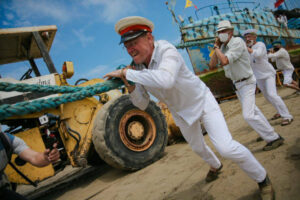
It is not long before the skipper is summoned to the Comandante. This harbor master lets you wait for two hours before receiving you in his immaculate white uniform with colorful bars on his left chest. How come we’re still in the fishing port? According to his papers we have entered in peril and must therefore leave as soon as possible in accordance with maritime law. I protest, saying that although we entered unsolicited, we did not enter in peril. He appears to be mistaken with a German ship and asks, with apologies, how long we would like to stay. I mumble April or so and tell him about our centenary ship and about the photo book we just made about our travels. If he would like to have one? That book is the optimal business card because it works better than a passport. It turns out that his wife’s sister was a great ballarina and whether he is allowed to visit the ship with his wife. Of course he is. But none of that happens because of the pandemic. Soon the Comandante is replaced by another Comandante and then another. Claudio the shipping agent dies of covid and takes the ship documents to his grave. It doesn’t take long before nobody knows how and why that old herring ship keeps bobbing around in the middle of that little harbour. She looks more and more rusty. The tuna fishermen are the only ones we are in contact with. The ship’s cat Moretti is most pleased.
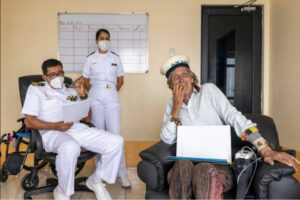
The skipper seizes the opportunity to finally organize his suitcases full of photos, flyers, posters, newspaper clips, ship documents and curiosities. More than thirty years are spread over the large ship’s table. The job takes months. It becomes a race with what he thinks is hernia. And when he finally goes to the big hospital in the big city, the hernia turns out to be a malignant tumor, as thick as a fist-sized potato that has nestled around three vertebrae of his spine. It takes nine hours in the first class hospital to extract it. By the end of 2020, a Dutch doctor gives him a life prognosis of a few months and with chemotherapy a few more months. That makes him looking for an opportunity to give the ship a new destination. On a beach? On an island? Which theater group is fool enough to want to take it over? What city is clever enough to want a centenary ship on its beach? Meanwhile, he drives around in a wheelchair. A lone Russian traveller guards the ship from looting and destruction. He is joined by a dog that was born on a neighbor’s fishing boat and whose strongest trick is barking. Moretti doesn’t mind.
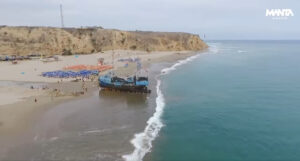
Early 2021 arise four ideas about a possible stranding. We talk with enthusiastic friends from Galápagos, but are afraid of the bureaucratic hurdles to be expected. The film-maker German Berger is negotiating with a Chilean town to simultaneously make a mix of documentary and feature film such as his production “Journey to Narragonia” from 2004. With that, the ship would finally have reached the so-called Fools’ Paradise Cockaigne or Narragonia. Then there is a theater group on an exotic Honduran island in the bay between Nigaruaga and El Salvador. But the decisive factor is the boldness of two actresses of the Ecuadorian theater group Humor and Life, who, with this impossible name, manage to seduce the mayor of Manta to welcome the ship. They tell him that an old captain of a world-famous theater ship has ended up in a wheelchair and that he wants to donate his ship as a theater put on the beach. The mayor smells electoral gunpowder. Six kilometers south of the city of Manta is San Mateo, a poor hamlet with five thousand souls of mainly fishermen. Fifteen years earlier, the government had allocated $9 million to build a fishing port for this community. But its calculations were wrong and the brand new harbor silted up. At low tide, the children play between the pier heads. Also, the fish is gone. But behind the pier a new, huge beach emerged. Lord Mayor now comes up with the bright idea to transform that messy beach into a chic Boulevard with the theater ship as the main attraction. The municipal planning department comes up with a well thought out design in which a playground of two thousand square meters is set aside for the ship. After thirty years of whimsical sailing, she will be neatly encapsulated between the parking lot and the bus terminal, between the parked fishing boats and the beach bars. Although, such designs tend to take ages to be realised.
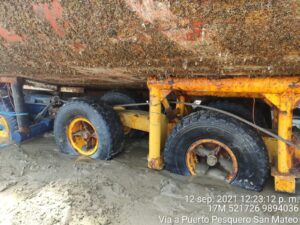
One hundred and fifty nautical miles north, the newest Comandante gets tired of that ship that for a year and a half got lost in his harbor. They don’t even have any documents. He warns the Coast Guard, which calls in the Ministry of Defense, which in turn informs the Dutch authorities. An inspection declares the ship “unable to sail nor to remain”. A familiar bureaucratic paradox. Seized again. He starts threatening with seven thousand dollars in overdue harbor dues and fines. In the meantime, the actresses and a team of friends organize a very expensive crowdfunding campaign that unfortunately does not cover its costs, but that does inform the country that a Dutch ship wishes to make a trip over the beach. A theater ship on the beach is an absolute first for the country. It is an excellent opportunity for the socio-cultural development of a disadvantaged community. My surgeon at the hospital also hears about it. The Commandant hears about it. The Vice-Minister of Culture hears about it and manages to obtain from her colleagues of Defense the exoneration of the measly harbor dues. The motor has been set in motion and can no longer stop. The Province lends two CaterpillarD8 bulldozers, each weighing 40 tons. Niels, the faithful ship’s mechanic, comes from Amsterdam to lubricate the engine, valves, taps and pumps one last time, cursing. The Coast Guard comes to inspect the ship one more time and congratulate us on the ship’s bell that sounds much better than that on their own warship. Next morning, the ship departs on her last voyage, to the fishing village of San Mateo. Halfway through, she crosses the equator for the first and last time.
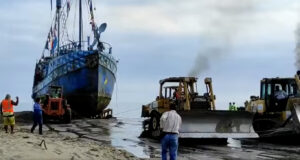
That is where the very last journey awaits, one hundred and fifty meters across the beach, on wheels. Engineer Rafael took the job for thirty thousand dollars. He mobilizes equipment and men: fifty workers equipped with a lot of cables and pulleys, sturdy shovels and two carts. Normally they pull a wooden fishing vessel up the beach with one such cart, but for the one hundred and eighty tons of iron, they bring two of those and weld them together. With their third-hand airplane wheels, they look familiar, as rickety and rusted as the old herring ship herself. The province’s two bulldozers are brought in on huge trucks and make a long path on the beach by pushing aside the loose sand. A comedy in three acts awaits us. At dawn and high tide, the double cart is driven out into the sea and the ship sails slowly into the bed that is formed by the cart. Divers, four dinghies and the cacophonous gabble of the workers in the dinghies and ashore accompany the operation. Within half an hour sounds the signal “Pull-it, pull it” and the bulldozers start moving. She goes! Eß gat, eß gat! La Nave Va! The ship is triumphantly pulled to the high tide line. Hurrah! She sails forty meters and then the cable, that turned out to be second-hand, breaks. She stands triumphantly on the high tide line and sinks deeper and deeper into the sand.
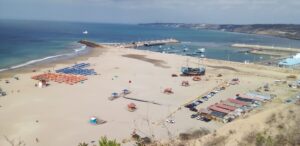
The second act lasts two days. Stones and tropical beams are brought in to put under the wheels – and are later removed. More bulldozers arrive with every futile attempt. Every time, the workers carry other cables. The connection between the two carts loosens up and the second cart is being pulled deeper and deeper into the sand. The gabbling keeps on going for two days. The Municipality, which is following the operation with great fanfare, is becoming increasingly nervous. The political opponents of the Lord Mayor demand drinking water in entire districts instead of this circus show. The Province wants the bulldozers back. The skipper watches the swarming from the wheelhouse with curiosity and mercy. He knows that the ship can never be pushed back into the sea. Mission accomplished. The opera Mefistofele reverberates across the deck. The Opera Ship is back, momentarily. We’ve come full circle. At night, at high tide, the water splashes and roars against the ship. The skipper sleeps wonderfull.
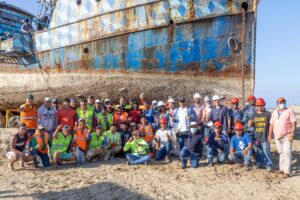
On the forth day, the engineer clambers up the rope ladder with his adjutants for crisis deliberation. They decide to pull up the ship with a very long cable and with pulleys from a fixed point in the village. They decide to deploy two extra bulldozers that simultaneously lift the second cart from the side. Afterwards, Rafael begs me to let go of the ship, to set her free. I answer that it’s not me who retains the ship, but that she herself does not want to leave the sea. After all, the centenary lady can still go to Australia, with ease! The sixty-year-old engine would have no problem with it either. Still, due to force majeure, it’s a sea too much and a desert too far. Subsequently, the operation went smoothly. Once freed from the sucking sand of the high tide line, the ship glides gently over the track the excavators had already drawn. That the long cable got caught in one of the caterpillars and breaks causes only a minimal delay. By now, we know we can. A spectacle with a happy ending. A rather expensive spectacle but most memorable, all the more so because the ship drives once again on wheels and thus returns to its historical origins as a wheel barge or, in other words, the most jolly cart of the carnival parade. At the end of the beach we drop anchor for the last time, which gave a nonetheless unexpected dull thud where we secretly hoped for the most exuberant splash, given the weight of the historic moment. It gives great comfort that, finally, the ship is showing off in full glory because until now we always have managed to carefully hide below sea level her monumental size and her most beautiful shape: her steep prow like Cleopatra’s straight nose and her curvilinear stern like Donald Duck’s curvaceous bum.
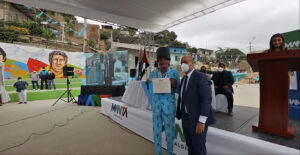
We lower the monumental staircase that hangs from the boom alongside starboard like a medieval drawbridge. Dressed in my sunday clogs, the skipper descends the steps. He’s last to leave the ship and embraces the engineer, under applause. Like the Pope, he had wanted to throw himself strehed out on the beach, but his stiff knees and back no longer allow it, so he asks the engineer for a handful of sand. An endless session of selfies follows with the new villagers, who happily pose with el Capitán as if with a half-saint. Lord Mayor already had set the example on social media. It is not the ship that is monumental, it is the nobility of his heart, his goodness, the lives he will change through art. At the annual village festival a few days later, the mayor’s exceptionally well-oiled election mill whizzes by. I went there by wheelchair. Blue and white city flags, bombastic speeches, pep talk, the national anthem, a slick video presentation and a slick lady singer. He hands out certificates of merit to some deserving neighbours. I’m getting one too. Last but not least. For that I lift myself out of the wheelchair, tjak-tjak, in clogs and in a blue suit with a motif of red tulips. Grin-grin, photo-photo. Mercedes, the cook of the neighbouring beach bar, tells the story of her great-grandfather August, an American sailor who stranded in the village and never left. We feel at home. Moretti is blissfully happy, with a catbox the size of the beach. Lives will change, thanks to art. With humor and life. As I was about to return to the Netherlands, a timely forewarned Miss San Mateo and her Vice Queen dropped by, both with wide sashes, for a goodbye kiss.
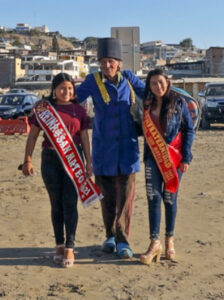
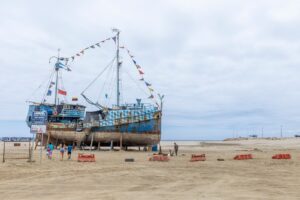

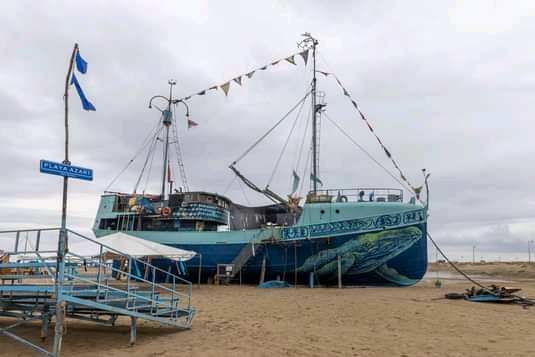


.jpg)
I live near Azartplein, I’m a foreigner, I recently moved to Amsterdam, and I didn’t know any of this. This story – which began so close, and ended so far away – moved me a little. It makes me a little sad to know that the ship will never return.
It is true, art is something immortal capable of changing lives.
A good reason to visit that place soon! I also live there in the neighborhood, How beautiful things also disappear, but in this case show back up in an even nicer spot!
nicely said Lucas